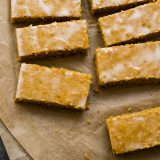Macau—a pint-sized peninsula on China’s southern coast-is a city of transference and flash. And it sports a killer sweet tooth.
Portuguese traders founded Macau in the 1550s, and the settlement's cuisine benefited from a worldwide network of colonies. Tubers from Brazil, spices from India, peppers from Africa and more, all merged with native Cantonese herbs, vegetables and techniques. The result was dishes like tacho, a cumin-spiced stew similar to Portuguese cozido, with Chinese salted duck filling in for Iberian ham.
As the city grew, Malay, Filipino and Indian migrants came looking for work. Today, the menu might include spicy African chicken, Vietnamese-style pork buns, Indian-influenced curry crab stir-fry and Portuguese custard tarts.
It's all just a quick ferry ride across the bay from Hong Kong. And it's considered the wealthiest city in the world by GDP, known as the Las Vegas of the East, a high-rollers' paradise of luxury hotels and Michelin-starred restaurants.
But all that flash obscures a remarkable culinary tradition—shaped by that amalgamation of cultures that funneled into the 11-square-mile city over hundreds of years.
Thanks to these diverse influences, Macau stands out from its neighbors in Southeast Asia. That’s particularly true with the territory’s predilection for baking, a technique rarely practiced elsewhere in the sweltering region.
The batatada—a cheesecake-like dessert made with potatoes—is a prime example. Its name comes from the Portuguese for potato, but the ginger-spiced, coconut-laced cake is unique to Macau. It often appears at afternoon tea (another imported tradition) and is standard at cha gordo, or fat tea—an elaborate celebratory spread prepared for holidays, birthdays and weddings.
The traditional batatada is rich with butter and egg yolks, with one version using starchy white potatoes and another favoring sweet potatoes or yams. The potatoes are boiled and mashed, then whisked into the wet ingredients. Coconut milk and sometimes coconut powder give it tropical flavor. The cake is dense and custardy, finished with a dusting of powdered sugar, a satisfying combination of Far East and New World—one we thought could translate well to American tastes.
For our own recipe, we chose to use sweet potatoes for the cake's base. We microwaved (rather than boiled) hunks of sweet potatoes. Besides saving time, it meant we wouldn't add unnecessary moisture to the batter.
In another break from tradition, we lightened the texture by eliminating some of the fat. We cut the butter, used whole eggs instead of yolks and replaced coconut milk with less-fatty whole milk. To maintain a strong coconut flavor, we included shredded coconut and coconut oil. We also spread the batter into a rectangular baking pan, which relieved some of the pressure to rise and gave us a lighter, quick bread-like crumb.
Finally, we made a quick powdered sugar glaze spiked with lime zest to add a sweet, citrusy note to the cake. Served warm, it felt familiar, even homey, while still carrying all the tropical—and blended—flavors of Macanese cooking.




